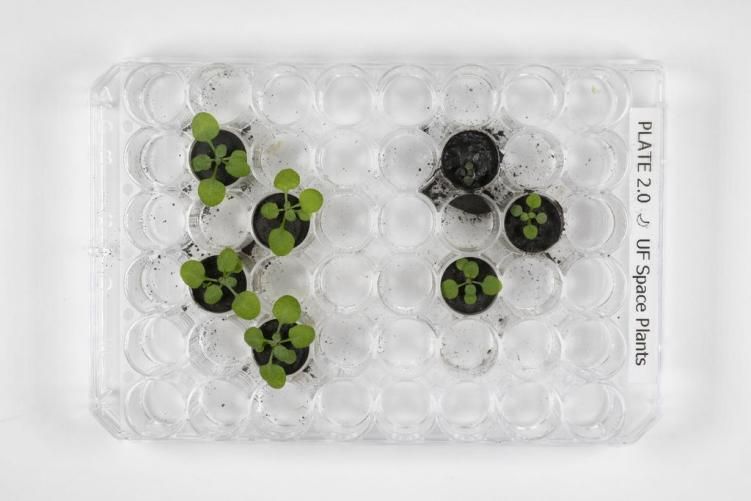
The Moon’s soil is called “regolith”, and there’s not a lot of it on Earth. It is so rare that it took scientists 11 years to persuade the authority to use it. There are three different types of regolith. One was taken from the top layer of the Moon’s surface, and the others came from deeper layers of the Moon’s soil.
Soil from the moon is very different from regular soil. It’s powdery and doesn’t have many nutrients—things that help plants grow. The soil has a large amount of iron, and is full of tiny pieces of glass from smashed meteorites(陨石).
The scientists chose a plant called thale cress(鼠耳芥) for their experiment. It’s a small plant related to broccoli that can grow in very little soil. Scientists know a lot about the DNA of thale cress, which helps them understand how it reacts to the soil it’s planted in.
The researchers separated the lunar soil into 12 tiny containers. They got the soil wet with water mixed with nutrients. Then they added seeds. To compare, the researchers also planted thale cress seeds in ash from volcanoes—a sort of fake lunar soil.
After two days of watering, the scientists saw green growths in every container. “Everything sprouted. I can’t tell you how astonished we were!” said the report’s lead author. As the scientists continued to care for the plants, they began to notice differences.
The plants grown in lunar soil weren’t as healthy as those grown in volcano ash. They were smaller and grew more slowly. Their roots didn’t develop as well, and some leaves turned red. The plants grown in the top layer of lunar soil did the worst of all.
The researchers say the growth patterns show that the plants were “stressed” by the lunar soil. Still, they were surprised that the plants were able to grow at all. By studying changes in the DNA of the plants grown in lunar soil, scientists may one day figure out new ways to help plants grow better in the Moon’s soil.
本时文内容由奇速英语国际教育研究院原创编写,未经书面授权,禁止复制和任何商业用途,版权所有,侵权必究!(作者投稿及时文阅读定制请联系微信:18980471698)
1.Which of the following best describes the lunar regolith?
A It is suitable for plants on Earth to grow.
B It came from the top layer of the Moon’s soil.
C It is used with permission from the authority.
D It took scientists a long time to know its nutrients.
解析:选C。C推理判断题。根据第一段的“It is so rare that it took scientists 11 years to persuade the authority to use it.”可知,月球土壤非常罕见,科学家们花了11年时间说服当局允许他们使用它。由此说明它被用于科学研究,是得到了当局的许可。故选C。
2.Which of the following is probably related to the scientists’ research? a.The plant selection. b.The study of volcanoes. c.The analysis of lunar soil. d.Comparing the plants in different soils.
A a;c
B a;c;d
C b;c;d
D a;b;c;d
解析:选B。B细节理解题。文章第二段介绍了月壤的成分,第四段介绍了科学家选择的植物,第六段介绍了种植在月壤和火山灰中的鼠耳芥的差异,这些都与科学家的研究相关。故选B。
3.What does the underlined word “sprouted” probably mean?
A Woke up.
B Prepared well.
C Hid oneself.
D Started to grow.
解析:选D。D词义猜测题。根据上文的“After two days of watering, the scientists saw green growths in every container.”可知,浇水两天后,科学家们在每个容器中都看到了绿色植物,即种子发芽了。由此猜测sprout意为“发芽,生长”。故选D。
4.What does the underlined part in the last paragraph imply?
A The Moon’s soil provides enough nutrition for plants.
B Scientists find ways to help plants grow better.
C The lunar soil changes the DNA of the plants.
D The plants can’t adapt to the lunar regolith.
解析:选D。D推理判断题。根据倒数第二段可知,生长在月壤里的植物没有生长在火山灰里的植物健康,在月壤里的植物更小、生长更慢。它们的根没有发育好,一些叶子变红了。生长在月壤表层的植物表现最差。由此说明这些植物不适应月球土壤环境。故选D。